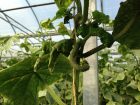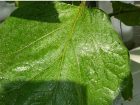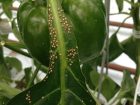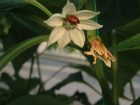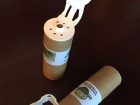
Features
Biocontrols
Inputs
Aphids a Major Issue in Ornamental and Vegetable crops
They can inflict serious losses even at very low populations.
September 5, 2017 By Dr. M. Ishtiaq Rao
September 2017 – Aphids can cause significant economic losses on ornamentals by causing deformities, reduced size, or by merely being present on the plants. Such presence affects the aesthetic value of infested plants, thereby reducing or preventing their marketability.
On vegetables, aphids inflict losses by reducing yield due to fruit distortion (Fig. 1), by causing development of sooty mould on leaves, and/or by transmitting virus infections.
More plant viruses are transmitted by aphids than by any other group of insects. In greenhouse cucumbers, cotton aphids are the most commonly occurring species, and some of the viruses they can spread in this crop include cucumber mosaic virus (CMV), watermelon mosaic virus (WMV), zucchini yellow mosaic virus (ZYMV), and papaya ringspot virus (PRSV). In greenhouse peppers and tomatoes, aphids may vector viruses such as tobacco etch virus (TEV), potato virus Y (PVY), and CMV.
Feeding damage caused by aphids and their ability to transmit viral diseases is greatly facilitated by their reproductive potential. Factors that contribute to their ability to reproduce exponentially include the following:
- Within the greenhouse, no mating is required for reproduction;
- Only female aphids are produced, with up to 200 young being produced per female.
- Each daughter can begin reproduction in seven to10 days.
Furthermore, aphids can inflict serious losses even at very low populations. Within 10-30 seconds, an aphid can pick up a virus from an infected plant, and just as quickly, infect a healthy plant while probing or making punctures to obtain plant sap. Once a single plant has been infected, further transmission can be carried out mechanically during harvesting and pruning. Such activities facilitate transmission of virus-infected sap from plant to plant.
Viruses can be spread even faster when winged forms of the aphids are present. Under greenhouse conditions, aphids multiply continuously and usually produce forms without wings. When conditions begin to deteriorate, such as during overcrowding and when food quality is poor, aphids produce forms that have wings. It is these winged forms that contribute most to spread of viral diseases. In fact, the presence of a few winged aphids will do more to spread a virus disease than a large number of non-winged aphids that are stationary.
MANAGEMENT STRATEGIES
Management of aphids in greenhouse crops requires an integrated approach that uses all available strategies including regular crop monitoring, weed control, biological and chemical controls.
Crop monitoring: Early detection of aphids requires regular and meticulous observation of the crop. Because aphids reside on the undersides of leaves, scouts can look for white flecks on the upper surface of leaves located immediately below the infested leaves. These flecks are the skins that the aphids have cast off during moulting (Fig. 2).
Other tell-tale signs include a shiny coating of honeydew (Fig. 2) or black sooty mould on the leaves. However, observation of sooty mould indicates an older infestation and a relatively developed population. In addition to observing the crop, yellow sticky cards must be used to detect the presence of winged forms. Such winged forms indicate either that overwintering aphids from outdoors have flown into the greenhouse, or that “hot spots” or concentrated areas of very high populations of aphids are present in the crop.
Weed control: It is necessary to try and eliminate or at least reduce potential sources of the virus. This means removal of weeds and any other type of plant species that could serve as a host for both aphids and viruses, in and around the greenhouse.
Aphids have a very wide host range. For example, the green peach aphid is reported to feed on hundreds of plant species from over 40 plant families. Weeds, particularly broadleaf weeds, play an important role as overwintering hosts for aphids and as reservoirs for viruses. The most common virus that infects cucumbers and its relatives is CMV, and this has been found to be naturally occurring in at least 476 plant species.
Biological control: Biological control can help in suppressing aphid populations but it is especially important to make releases early in the development of aphid populations. This is because there is a lag time between release and reduction of populations. Biocontrol agents that are commercially available include parasitic wasps such as Aphidius matricariae, A. colemani (Fig. 3), A. ervi, and Aphelinus abdominalis. Whereas A. matricariae and A. colemani are generally used for the smaller aphid species such as green peach and cotton aphids, A. ervi and Aphelinus abdominalis are used against the larger aphid species such as potato and foxglove aphids. Predators available include green and brown lacewings, the predatory midge, Aphidoletes aphidimyza, and ladybeetles (Hippodamia convergens) (Fig. 4). Generally, the parasitic wasps are released early when aphid populations are still low, and the predators are used to supplement the activity of the wasps, particularly in “hot spots.”
Maximize the effectiveness of aphid enemies: The conventional method for applying aphid biocontrols, particularly parasitoids, involves sprinkling parasitized aphid mummies on the plants and allowing the parasitoid wasp to emerge. But buyer beware: in hymenopterans (such as Aphidius and Aphelinus), the males emerge first and go out in search of nectar. When the females emerge, all the males have left the area, meaning no mating is occurring. The wasps end up scattered in an enormous greenhouse, and mating becomes a much less likely event. Not only does mating become less likely, but the energy that the wasps must expend in searching for nectar and a mate leaves less and less energy available to search for aphids.
To increase wasp efficiency, some suppliers, such as Crop Defenders, supply their wasps in a cardboard tube with a nectar solution affixed near the exit hole (Fig. 5). This way, the adult wasps emerge well-fed and already mated. The mated females then go out immediately in search of aphids within which to lay their eggs. Aphidoletes, though not a parasitic wasp, behaves in a very similar way, and benefits just as well from the tubes supplied with nectar. This pest control technique means that with the same investment, you get more bang for the buck.
Chemical control: Given frequent exposure to any pesticide, the short life cycle and reproductive potential of aphids enable them to successfully develop resistance to any pesticide. Thus, chemical controls are best used minimally, and only when absolutely necessary.
To facilitate use of chemical controls, a good monitoring program is necessary to indicate proper timing of applications, and also where applications should be made in the case of spot treatments. To delay development of resistance, it is always best to combine several strategies including the following:
- Apply pesticides as a last resort.
- Minimize pesticide use by making partial applications, e.g. only in the upper canopy or only on plants in “hot spots” versus application to the entire crop.
- Practice rotation by using products from different pesticide families.
- Increase the use of biocontrols, combining several species as necessary.
- Remove plants or leaves that are extremely heavily infested.
In summary, aphids usually cause problems in greenhouse crops at this time of year. In anticipation of this event, we need to harness all available strategies to minimize their populations and the threats that they pose to our crops. This can only be done by using an integrated approach that incorporates crop monitoring, sanitation practices, early releases of biocontrols, and judicious use of pesticides.
Dr. M. Ishtiaq Rao, CEO of Crop Defenders Ltd., is a PhD in entomology who is dedicated to the eradication of horticultural pests through IPM methods. Crop Defenders Ltd. utilizes biological knowledge of pest and beneficial insect species in order to manage pests cost-effectively and in a way that is cohesive with a healthy environment.
• ishtiaq@cropdefenders.com
Print this page
